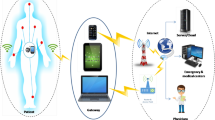Abstract
The need for secure communication in Wireless Sensor Networks (WSNs) is increasing as more and more complex sensors are being developed and deployed for a variety of purposes. Secure communication in WSN can be made possible by using secret group key. However, securely distributing group key among sensor nodes is a difficult task and requires very complex mathematical calculations. The schemes presented so far are either vulnerable to various security attacks or have high computational and storage complexity. This paper presents a new Group Key Distribution scheme with Mutual Healing (GKDMH) which is based on Chinese Remainder theorem. The proposed scheme has better performance than existing schemes in terms of computational and storage complexity, and provides mutual healing in case of missed transmissions.




Similar content being viewed by others
References
Agrawal S, Das M (2016) Node revocation and key update protocol in wireless sensor networks. In: Proceedings of IEEE International Conference on Advanced Networks and Telecommunications Systems, ANTS, pp 1–9. https://doi.org/10.1109/ANTS.2016.7947799
Agrawal S, Das ML (2017) Mutual healing enabled group-key distribution protocol in Wireless Sensor Networks. Comput Commun. https://doi.org/10.1016/j.comcom.2017.08.014
Bhaskar P, Pais A (2015) A Chinese Remainder Theorem based key management algorithm for Hierarchical Wireless Sensor Network. In: Proceedings of International Conference on Distributed Computing and Internet Technology (ICDCIT), vol LNCS 8956, Springer, Berlin, pp 311–317
Blundo C, Darco P, De Santis A, Listo M (2004) Design of self-healing key distribution schemes. Designs Codes Cryptogr 32(1–3):15–44
Chen C-L, Tsai Tzay-FarnShihYu-Ting, Li D-K(2015) A bilinear pairing-based dynamic key management and authentication for wireless sensor networks. https://doi.org/10.1155/2015/534657
Du X, Wang Y, Ge J, Wang Y (2005) An ID-based broadcast encryption scheme for key distribution. IEEE Trans Broadcast 51(2):264–266. https://doi.org/10.1007/11839569_47
Gu J, Xue Z (2010) An efficient self-healing key distribution with resistance to the collusion attack for wireless sensor networks. In: 2010 IEEE International Conference on Communications (ICC), IEEE, pp 1–5. https://doi.org/10.1109/ICC.2010.5502594
Han S, Tian B, He M, Chang E (2009) Efficient threshold self-healing key distribution with sponsorization for infrastructure less wireless networks, Wireless Commun. IEEE Trans 8(4):1876–1887. https://doi.org/10.1109/TWC.2009.080046
Han S, Tian B, Zhang Y, Hu J (2010) An efficient self-healing key distribution scheme with constant-size personal keys for wireless sensor networks. In: 2010 IEEE International Conference on Communications (ICC), IEEE, pp 1–5. https://doi.org/10.1109/ICC.2010.5501988
Hong D, Kang J-S(2005) An efficient key distribution scheme with self-healing property. IEEE Commun Lett 9(8):759–761. https://doi.org/10.1109/LCOMM.2005.1496607
Lauter K. The advantages of elliptic curve cryptography for wireless security. IEEE Wirel Commun 11(1):62–67. https://doi.org/10.1109/MWC.2004.1269719
Liu D, Ning P, Sun K (2003) Efficient self-healing group key distribution with revocation capability. In: Proceedings of the 10th ACM Conference on Computer and Communications Security, ACM, pp 231–240
Liu Y, Harn L, Chang C (2014) An authenticated group key distribution mechanism using theory of numbers. Int J Commun Syst 27(11):3502–3512. https://doi.org/10.1002/dac.2569
Louw J, Niezen G, Ramotsoela TD, Abu-Mahfouz AM (2016) Key distribution scheme using elliptic curve cryptography in wireless sensor networks. https://doi.org/10.1109/INDIN.2016.7819342
Lv X, Li H (2013) Secure group communication with both confidentiality and non-repudiation for mobile ad-hoc networks. IET Inf Secur. https://doi.org/10.1049/iet-ifs.2010.0314
Rams T (2013) Pacyna. A survey of group key distribution schemes with self-healing property. Commun Surv Tutorials IEEE 15(2):820–842. https://doi.org/10.1109/SURV.2012.081712
Rams T, Pacyna P (2013)Long-lived self-healing group key distribution scheme with backward secrecy. In: Conference on Networked Systems (NetSys), IEEE, pp 59–65. https://doi.org/10.1109/NetSys.2013.19
Shim K-A, Lee Y-R, Park C-M(2013) EIBAS: an efficient identity-based broadcast authentication scheme in wireless sensor networks. Ad Hoc Netw 11(1):182–189. https://doi.org/10.1016/j.adhoc.2012.04.015
Staddon J, Miner S, Franklin M, Balfanz D, Malkin M, Dean D (2002)Self-healing key distribution with revocation. In: Proceedings. 2002 IEEE Symposium on Security and Privacy, IEEE, pp 241–257. https://doi.org/10.1109/SECPRI.2002.1004375
Steiner M, Tsudik G, Waidner M (2000) Key agreement in dynamic peer groups. IEEE Trans Parallel Distrib Syst 11(8):769–980. https://doi.org/10.1109/71.877936
Tanwar S, Kumar A (2017) A proposed scheme for remedy of man-in-the-middle attack on certificate authority. Int J Inform Secur Priv (IJISP) 11(3):1–14
Tanwar S, Kumar A (2019) An efficient and secure identity based multiple signatures scheme based on RSA. J Discrete Math Sci Crypt 22(6):953–971
Tian B, Han S, Hu J (2011) Dillon. A mutual-healing key distribution scheme in wireless sensor networks. J Netw Comput Appl 34(1):80–88. https://doi.org/10.1016/j.jnca.2010.09.002
Vijayakumar P, Bose S, Kannan A (2014) Chinese remainder theorem based centralised group key management for secure multicast communication. IET Inf Secure8(3):179-187. https://doi.org/10.1049/iet-ifs.2012.0352
Ye N, Zhu Y, Wang R-c, Malekian R, Lin Q-m(2014) An efficient authentication and access control scheme for perception layer of internet of things. Int J Appl Math Inf Sci 8:1617–1624
Zheng XL, Huang CT, Matthews M (2007) Chinese remainder theorem-based group key management. Association for Computing Machinery Proc. 45th Annual Southeast regional Conf. (ACMSE-07), Winston-Salem, North Carolina, USA, pp 266–271
Zhou J, Ou Y-H(2009) Key tree and Chinese remainder theorem-based group key distribution scheme. J Chin Inst Eng 32(7):967–974. https://doi.org/10.1080/02533839.2009.9671584
Author information
Authors and Affiliations
Corresponding author
Ethics declarations
Conflict of interest
The authors Neeraj Patel and Vinod Kumar certify that they have NO affiliations with or involvement in any organization or entity with any financial interest (such as honoraria; educational grants; participation in speakers’ bureaus; membership, employment, consultancies, stock ownership, or other equity interest; and expert testimony or patent-licensing arrangements), or non-financial interest (such as personal or professional relationships, affiliations, knowledge or beliefs) in the subject matter or materials discussed in this manuscript. The Submitted manuscript is an original research article. The Corresponding author of this manuscript is Neeraj Patel. Thank you for your consideration of this manuscript.
Additional information
Publisher’s Note
Springer Nature remains neutral with regard to jurisdictional claims in published maps and institutional affiliations.
Rights and permissions
Springer Nature or its licensor holds exclusive rights to this article under a publishing agreement with the author(s) or other rightsholder(s); author self-archiving of the accepted manuscript version of this article is solely governed by the terms of such publishing agreement and applicable law.
About this article
Cite this article
Patel, N., Kumar, V. An efficient key distribution Scheme for WSN with Mutual Healing Capability. Multimed Tools Appl 81, 36735–36749 (2022). https://doi.org/10.1007/s11042-022-13501-y
Received:
Revised:
Accepted:
Published:
Issue Date:
DOI: https://doi.org/10.1007/s11042-022-13501-y




